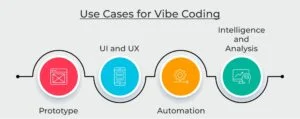Andrej Karpathy, a founding member at OpenAI, coined the term “Vibe Coding” earlier this year. It is a way that natural language is transformed into working code within minutes. You could construct a working app by telling the instructions in English.
This technology is a game-changer for all creators and non-creators. Now, all the non-specialized entrepreneurs can also get their ideas going. As vibe coding opens new doors to innovation and minimizes the constraints for the same, it also has put forward some important questions about security, efficacy, and quality of the codes.
In this blog, we will check out Vibe coding and the risks it poses to software development.
Vibe Coding: What is It?
When you use natural-language prompts and LLMs to generate working code, UIs, or configurations, here, the user is expressing intent or the “vibe” for the AI to implement the ideas.
But why is vibe coding gaining sudden interest?
Well, there have been some improvements in LLM, and the tool incorporation has allowed platforms like Cursor and Bolt to translate commanding explanations into working code and live prototypes as well.
What Advantages Does Vibe Coding Deliver?
A substantial number of advantages are delivered by Vibe coding.
- Enhancement in productivity
- Increased prototyping and
- High diagnostic ability to decrease the constraints between ideas and enforce them
- Fusion of automation and experimentation produces a dynamic and innovative environment
- In that environment, developers can easily experiment with features and new ideas for innovation
This liberty affords them the time to pay more attention to advanced matters, such as design, frameworks, and scalability. This results in whole new insights, developments, and improvements in the way software is built.
When can vibe coding be advantageous, and who can benefit from it? Let’s examine a few use cases where Vibe Coding has had an impact.
Use Cases for Vibe Coding
Its appeal is rising as it combines creativity and speed with automation, with insights from humans.
We have mentioned use cases below –
Prototype – It is perfect for rapidly developing minimum viable products or prototypes. In just a few minutes, you can describe a feature like “a dashboard with three charts and a filter” and receive functional code.
UI and UX – Ever required a HTML/CSS layout? Based on your description, vibe coding can produce aesthetically pleasing interfaces.
Automation – The AI will produce Python or R code if you specify a task, like clear this CSV and plot an illustration. Marketers and analysts who wish to automate recurring tasks will find this especially helpful.
Intelligence and Analysis – Observing how the AI resolves issues is an excellent method of learning coding concepts. You can try variations to see different methods or ask it to explain what it’s doing. Vibe coding facilitates more creative exploration, quicker workflows, and greater accessibility. The use cases we just discussed demonstrate how it can enable interdisciplinary teams to proceed from concept to implementation at a never-before-seen pace.
However, it has compromises, just like any other powerful tool. If not used carefully, its benefits like speed, adaptability, and ease—can also turn into challenges. Therefore, it’s worthwhile to examine the areas in which it may be inadequate as well as the dangers that teams should be mindful of when implementing it widely.
What Risks Does Vibe Coding Pose for Scalable Software Development?
Just like pretty much everything in this world, when there are exciting prospects, there are also challenges that come along with it. This demands a considerate and accomplished approach.
Hence, creating prompts that work and coupling them with a complete and understanding of the elementary code are important to achieving secure and reliable outcomes.
The quality of the output depends upon the quality of the input – AI responds literally to the prompts that are fed to the LLM. Unclear or too extensive prompts can produce weak or risky code. On the contrary, a clear and properly articulated input, such as expectations, contexts, or security constraints, can create strong and secure code.
But a perfect prompt isn’t everything – The job is not done. There needs to be analysis, testing, and polishing of the outputs composed by the AI. This entails verifying assumptions, looking for logical errors, and making sure the code complies with the project’s goals. It’s essential to consider whether the code executes correctly, rather than just whether it works.
The issue of discoverability lingers – when a code is written, there is a reason behind making those decisions; you can question it, record it, or rectify it. When a code is generated by AI, those decisions are a bit cloudy. You may be left with questions like, ‘Why was that choice made?’ Without a clear intent, the rectification becomes conjecture, and safekeeping becomes dicier with time.
Concerns about Performance – AI may produce code that functions but isn’t optimized, which could lead to scalability issues, slower execution, or increased resource consumption. That can be a deal-breaker in situations where the stakes are high.
Concern of Overdependency – While AI can be a helpful co-pilot, engineering retribution cannot be replaced by it. Teams run the risk of introducing minor bugs, security holes, or architectural debt that is difficult to undo later when they begin to trust the output without question.
Parting Ways to Keep in Mind
Vibe coding is already changing early-stage product development and is a powerful speed and creativity machine. The potential is huge for creators, founders, product builders, and designers, offering quick validation, reduced expenses, and the freedom to try things out without waiting for engineering cycles.
However, the tool is not a cure-all. It can create vulnerability, risk, and shadow IT if it is not accompanied by safekeeping, testing, and engineering alliance. The most ingenious companies will approach vibe coding as the initial phase of a methodical, human-centered lifecycle with quick prototype and thoroughly validated.
Check out YourTechDiet for all the blogs related to the latest AI trends!
Also Read:
Natural Language Processing: The Future of Communication
Exploring the Implications of Generative AI natural language processing for Marketers


